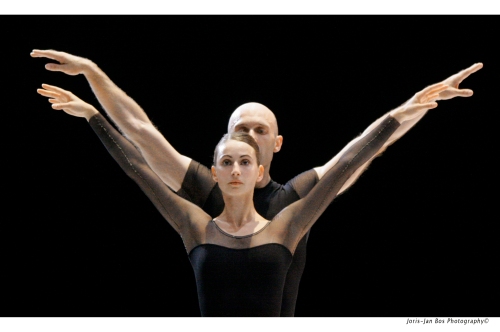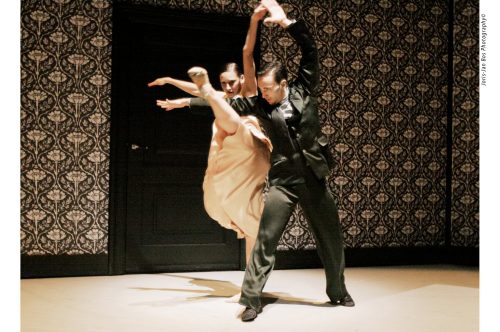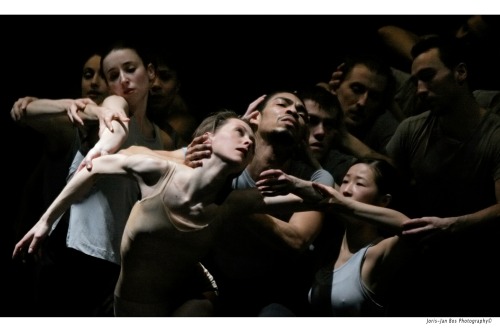At long, long last, NDT I brought a full program of recent work to Chicago which it repeats with some casting changes tonight at the Auditorium Theatre. As was noted by Sid Smith in Sunday’s Tribune, NDT and Hubbard Street Dance Chicago are now inextricably linked through an almost-baroque bit of musical chairs played out over the last decade. Indeed, departing NDT director Anders Hellström has officially passed the torch to Jim Vincent, toasting him following Tuesday’s performance and predicting Chicago will host the company more frequently than once a generation under Vincent’s leadership. I hope he’s right.
But this transatlantic Going to Jerusalem is only intrigue in the margins. What remains in the foreground at NDT is the art of dancemaking and an alignment of all personnel and resources toward the creation and presentation of pieces that are of deep and lasting significance to the course of dance history. It’s a tall order this company takes on — they’re self-defined as “constantly moving ahead to let the future of dance take shape” — and as such one must honor the fact that, for the most part, they fulfill it completely.
As I mentioned in preview, this is still very much The House That Jiří Built. Wings of Wax, the 1997 octet that represents him on the program, is mid-Nineties Kylián in a nutshell. Like his 1994 solo Double You, which I was fortunate to see danced with disturbing intensity by Václav Kunes four years ago, Wings lets the passage of time (literally) hang over the stage: Michael Simon’s design suspends a large lamp on a cable and slowly rotates it around an uprooted and upside-down silver tree. Its fragile dendrites, backlit, are cast in shadow; each orbit of the lamp is a year, the tree a big, dead Earth in a Ptolemaic universe. (In Double You, two massive chrome globes swing back and forth upstage, falling in and out of sync ticking off opposing sets of interminable seconds.) Wings is compositionally a retread of ideas born in 1991′s Petite Mort, beginning with an ensemble dance, occasional pairings and male firepower before focusing in on four achingly brilliant duets; its last image, in fact, is essentially a looping of Petite‘s. Still, it’s chock-full of moments it’s hard to believe you’re seeing, to say nothing of comprehending their invention. The second long duet in particular is a tour de force of expressive feet and artfully-managed momentum. All four men (Kenta Kojiri especially, plus Lukas Timulak, Stefan Zeromski and Bastien Zorzetto) offered interpretations that combined twelve-cylinder power with a jeweler’s precision.
One recent of many collaborations between Paul Lightfoot and Sol León, Shoot the Moon opened the show, setting its troubled mood and monochromatic palette. It’s another demonstration of NDT’s enviable budget for set design; the European model of arts funding is obviously much more hospitable to Gesamtkunstwerk than the American tradition of begging for corporate table scraps. The performers’ space is a shallow triangle extending from the apron to about center-center at which point three walls converge, two visible at a time, the other out of sight behind. Three men and two women share protagonist duties as the set rotates, possibilities of the nature of their relationships metastasizing as the piece progresses. Subtle, curious details abound: The striking design of the rooms’ wallpaper is in one chamber the negative of the others, the doors are squat and wide, and Fernando Hernando Magadan repeatedly sits on the sole windowsill, one leg and arm on each side of its mullions, bisected by the missing panes like one of Hirst’s lambs. Above the set are two panels that periodically display live-fed video that’s never too much for the onstage action — each usage serves a distinct purpose and facilitates an effective point of view.
Shoot the Moon is comprised of an immense vocabulary, not just in its many “steps” but its wild varieties of texture and maniacally mutating facial expressions. It’s at first too much, a sudden drop into motormouthed rambling disinterested in communication, but aided by the monotony of Philip Glass’ Tirol Concerto (Second Movement) and Lightfoot-León’s wise insertions of pauses and repetitions, the wash of information begins to reveal itself as the re- and re- and re-iteration of these five characters’ pacing within the confinement of their crises. Two dancers side-by-side face the audience, their mouths forming a flood of words like they’re pleading for rescue from behind bulletproof glass. At this moment, Moon is simultaneously honoring its conceits and inducing an instinctual impulse to step onto the stage and become their savior; my inability to do so generated what almost felt like guilt. I was moved and awed by this device — Lightfoot-León find a way to make you care about people you have no reason to, who are identified only in the vaguest sense by movement of the most abstract sort. Surely not all of these people are victims, some must be heroes and others villians, but the muting of their voices leaves only the pain of things not being the way you wish they were and exposes the universality of this agony regardless of whether it’s just.
I worked with Crystal Pite from 2004-2005 on Xspectacle/The Stolen Show, an evening-length work created during her residency at BJM Danse Montréal. It was fascinating to see how many of her choreographic motifs found new expression in The Second Person, premiered by NDT in 2007. Whereas in Xspectacle projected supertitles provided comment on and extrapolation of the action, The Second Person uses voiceover narration (by Kate Strong) as the narrative thread. Strong’s voice, properly British and uncannily like Emma Thompson’s, makes simple declarations about what “you’re” doing, “your head,” “your back” and the like as 24 dancers move through a series of scenes rich in Pite’s space-devouring, organically-mechanized material. [Apropos of nothing, I have to mention Joke Visser’s gorgeously-fitted menswear and the sometimes-crunchy, sometimes-lush score by Owen Belton (with whom Pite has collaborated for fifteen years on dozens of projects).] From its opening tableau — a wooden mannequin puppeted as though marching laboriously into a harsh wind — it immediately frays into a delta of streams, including everything from huge floor sequences in unison to the goofy physical comedy and trickily-manipulative duets at which Pite excels. Each moment of The Second Person is in itself crystal (sorry) -clear — at one point, a dancer wheels a miniature of Vorm & Dekor and Roelf Visscher’s backdrop of a smoggy cityscape across the stage — but this divergent construction begins to strain under its breadth. The image of the puppet, however, reappearing unexpectedly and even climbing over the body of a prone dancer, remains a clue to the piece’s throughline, echoed in the partnering’s active-passive dynamics. All at once Pite is showing how societal structures operate the individual, how intimates steer one another, and how choreographers utilize the bodies of others to make their statements. When these three layers are ironed together in a closing solo (sublimely interpreted by Sandra Marin Garcia), Pite’s numerous little wagers pay out in an enormous, synchronized jackpot that had me in tears.
http://trailerpilot.com/2009/06/17/nederlands-dans-theater/




